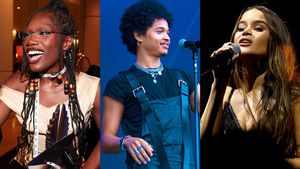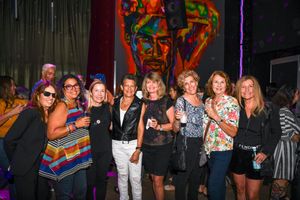To get to the house where the terrible thing happened, you leave behind the small-scale, mid-century charm of downtown Indianapolis for I-65 South, merge onto I-70 West for a good eight miles, then turn south on IN-67 down a five-mile, nondescript strip of fast-food chains, gun shops, and car dealerships. Turning left past a giant shopping plaza called Heartland Crossing, you come to a fairly dense development of nearly identical, vinyl-sided, box-shaped, two-story homes that stretch flat as far as the eye can see. There, at 9160 Middlebury Way, two men who were certainly intimates and may once have been lovers -- Milton Lindgren, 70, a semiretired accountant, and Eric Hendricks, 73, a retired mapmaker disabled by neuropathy -- were brutally murdered last October. Before their deaths, their cable and phone lines had been cut twice and a note reading fags was left on their door.
At first the murders appeared to be a hate crime, and they intensified a call from activists to pass a law enhancing punishments for such offenses in Indiana -- one of five states without a hate-crimes law and one of 19 without hate-crimes protections covering sexual orientation. But on November 15 the very man who found the bodies -- then-56-year-old Michael Brown, whom the two men had befriended and taken in several months earlier, and who attended Lindgren's funeral on October 30 -- was arrested and charged with the murders. Suddenly an obvious-seeming hate crime became something much more complicated. If the men weren't killed explicitly because of their sexual orientation, did their being gay have anything at all to do with the tragedy?
Lindgren, at 6 foot 10, and Hendricks, at 6 foot 6, were both very tall men. Lindgren, who collected toy trains and Wizard of Oz dolls, grew up in a conservative Lutheran home in Minnesota, eventually becoming an accountant for GTE and settling north of Indianapolis with his wife, Mary Ellen, and their two adopted daughters, Shahannah and Maria. He and Mary Ellen divorced in 2003, after 30 years of marriage, when Maria, snooping on her father's computer after she and her mother became suspicious about his behavior, discovered he was meeting men for sex. Hendricks was a hobbyist writer who grew up in Atlanta, attended the University of Georgia, and worked as a mapmaker for Rand McNally. He and his partner of 25 years, Tom Hitchner, lived all over the country until Hitchner died of AIDS-related complications nearly 20 years ago. Hendricks then moved to Indiana to be with a man he'd met online; their relationship lasted three years.
According to Hendricks's brother and sister-in-law, Steve and Sharon Hendricks, who live in Massachusetts, Lindgren met Hendricks in a gay chat room sometime in 2002 and moved into Hendricks's Indianapolis apartment the following year. In July 2004 the men bought and moved into the two-story, two-bedroom house at Heartland Crossing, with their beloved dachshunds, Strudels and Sebastian, in tow. They joined a sprinkling of other gays in the placid, middle-class development.
Press reports following the murders asserted that the men were lovers, and Lindgren's daughter Shahannah Roudebush says they were. Neighbors and friends say the men's relationship was affectionate but sexless and that much of it involved Lindgren caring for a largely housebound Hendricks. Hendricks, they say, rarely strayed from the second floor, staying up all night on the computer and sleeping all day, while Lindgren had the run of the first floor.
On the whole, the men seemed to complement each other, according to Sharon Hendricks, who says Lindgren was "totally nonjudgmental -- just a gentle, gentle man," while her brother-in-law "could be acerbic and outspoken," with observations about people that were often "dead-on." The men shared a love of genealogy and spent hours online researching their respective family histories. Hendricks "was always looking for controversies to get the blood going," says his brother, Steve, adding that Hendricks loved to ridicule people who didn't believe in evolution. But Lindgren, Steve says, "didn't join in -- he was definitely a true Christian."
Everyone describes Lindgren as a stolid Minnesotan of German-Swedish stock; neighbors didn't know Hendricks as well because his disability kept him largely at home. "He was a private individual and didn't like to talk about things that much," says Lindgren's friend Kent, a paralegal who asked that his last name not be used. Lindgren's reluctant coming-out bitterly divided his traditional Lutheran family back in Minnesota: His two brothers deserted him while his sister, Myrtle Brandvold, stuck by his side. "One of my other brothers would always go to the races in Indy," Brandvold says, "and every year Milt would say to him, 'Come stay with me,' but he never would."
Both Lindgren's ex-wife and his daughter Maria Douglas cut him off completely, while his other daughter, Roudebush, who lives outside Indianapolis with her husband and young daughter, stayed close to her father, instead distancing herself from her mother and Douglas. Shahannah says that when her mother learned about the murders, "She said to me, 'Well, he had it coming -- he deserved it.' "
As for Douglas, in an e-mail exchange with The Advocate she explained that her issue with her father wasn't that he was gay but that he'd lived a double life behind his family members' backs. "I asked my dad if he was gay and he said no," wrote Douglas, now married with three kids. "He never apologized for the cheating, never admitted what he had done, and never owned up to who he was." Mary Ellen Lindgren declined to talk about her ex-husband at length. "I feel terrible about what happened," she says of the murders. "It's just despicable." But did she really say that they were inevitable, as Roudebush claims? Yes, Lindgren says -- because of her ex-husband's secret trysts.
Those hookups continued in the home he shared with Hendricks. After coming out, Lindgren became a nudist and joined Bare Indy Boys, a gay and bisexual men's group that meets monthly in members' homes for nude potluck dinners. He also posed naked for art classes at the Indianapolis Art Center, where he was a favorite among the ladies who paint there, according to an instructor. A few times, says Kent, who met Lindgren through Bare Indy Boys, Lindgren hosted guys from the group for strip poker, being careful to keep things quiet so Hendricks, upstairs, didn't hear.
"[Hendricks] didn't want strangers in the house," says a man who met Lindgren online and went over to the house for sexual encounters with him. Over a grilled cheese sandwich at a Bob Evans restaurant in the Heartland Crossing complex, "Rick," a 45-year-old who prefers not to use his real name and who lives nearby with his mother and works the graveyard shift at a distribution center for a well-known company, shared transcripts of several instant-message conversations he'd had with Lindgren throughout 2008. Mostly banal ("I have an acorn squash in the oven so we can eat in about an hour," Lindgren tells Rick before a hookup, with Rick responding, "I'm having fish but thx anyway"), they don't mention any of the incidents, like the cut wires or the "fags" note, preceding the murders.
But the last chat, dated September 21, just a few weeks before the men were killed, gives pause: Lindgren and Rick, who were always looking for places to hook up other than 9160 Middlebury Way so as to avoid Hendricks, discussed meeting at the home of another, unnamed sex buddy of Lindgren's -- someone who, Lindgren wrote, is "into a little kink like light bondage" and who "has tied me up a few times and then mostly sucked me and did a little cbt" (short for cock-and-ball torture). The casual revelation suggests just how much risk Lindgren was perhaps willing to take when it came to meeting other men.
According to Hendricks's sister-in-law Sharon, not all visitors to the men's home were unknown to Hendricks. She remembers visiting the two at a time when her brother-in-law was jealous and peeved that Lindgren was temporarily housing some young gay men who needed a place to stay. "I thought they were likable young guys who were down on their luck," she says.
That combination of generosity and perhaps sexual interest on Lindgren's part, plus maybe a semi-obligatory complaisance on Hendricks's part, created the perfect setting for an affable, mild-mannered, middle-aged stranger named Michael Brown to nudge his way into the men's lives sometime in late 2007 or early 2008. Those interviewed believe that Brown met Lindgren online and said he was a doctor who had transferred from Colorado and needed a place to stay until he got his own place and his Indiana medical license set up. "[Brown] said to [my housemate and me], 'If either of you have a [medical] problem,' to let him know," says Bev Marker, who lived across the street from Lindgren and Hendricks. "I didn't get bad vibes from him."
But then, says Sharon, Brown called her out of the blue in March 2008 to say that Hendricks was chronically incontinent (true, she says) and needed to be put into a nursing home. Though she says that she and her husband were stunned to receive such advice from a stranger, they didn't talk to Hendricks or Lindgren about it because they didn't want to interfere with their lives too much.
Then, one weekend in August 2008, the outdoor telephone and cable wires to the men's home were cut. Lindgren had them fixed, but they were cut again the next night, this time with the homophobic note left on the front door. By this point, according to both Roudebush and Marker's housemate, Elizabeth Lilly, Brown was no longer living with the men. Still, he was around the house a great deal, and his car (a Toyota or Honda, Lilly recalls) was a familiar sight in the men's driveway. When Lindgren came over to show Marker the "fags" note, she says she urged him to call the police. But after the officers arrived, they told Lindgren that they couldn't get fingerprints off the paper, Lilly says. (The police report doesn't mention anything about fingerprinting the note.)
Kent says Lindgren told him and others in the nudist group about the incidents but that Lindgren "just didn't think it was a big deal." Yet Roudebush says that when she talked to her father, shortly after his 70th birthday, on August 31, she detected a strain in his voice. "He said, 'You know, there's these kids in the neighborhood pestering me. If they'd just leave me alone.' He was frustrated, but nothing to the point where he thought his life was in jeopardy."
Then, in late September, according to the probable-cause affidavit from the prosecutor's office, Lindgren and Hendricks showed up at their local post office, concerned that they hadn't received mail in a long time. They became "visibly upset," according to a postal staffer, when they learned that, back in February, Hendricks's signature had been forged on a card requesting that the men's address be changed to another in Indianapolis -- an address that, in the police investigation, showed up on items alongside Michael Brown's name. Soon after the men changed their address back, they learned that Brown had been using their credit cards.
Prosecutors believe that Lindgren and Hendricks were murdered sometime between October 5 and 10. According to Marker and Lilly, several days passed when they didn't see the men and the house seemed closed up, but they figured the two had rented an RV and gone off with the dogs to visit Lindgren's sister in Minnesota, as they often had. Lilly says she eventually left two messages on Lindgren's cell phone to see if the men were OK. Marker's recollection during this period is eerie: She got home late from work the night of October 6 -- she happens to be a criminal defense lawyer -- when Brown walked up, seemingly out of nowhere, and asked if she'd seen the men recently. She remembers that Brown said something about looking after the men's mail while they were on vacation but that he thought they should have been home by then. At the time, Marker knew nothing about Brown's defrauding the men, but she says, "Something about that night just didn't feel right." Still, she says, she didn't think to call the police. "Something like what ended up happening just really didn't enter my head."
There was a nudist potluck on October 19, a day before the bodies were found. Kent and the others there remarked on Lindgren's absence. Normally he'd let them know if he wasn't coming. But Kent didn't call or e-mail Lindgren. "I guess I didn't think anything about it," he says.
The next day, Brown brought his concern about the two men to next-door neighbor Kevin Tetrick. The two approached the house, which started the dogs barking inside, and got into the house via an open back window. They were immediately assaulted by an odor of decay. Tetrick declined to go upstairs, but Brown did, calling down, "Oh, my God, there's blood everywhere." Lindgren and Hendricks, found in their separate bedrooms, were killed by blunt-force impact to the head -- brutally bludgeoned, probably with something like a baseball bat, according to the police report.
Brown attended Lindgren's memorial service, appearing to most family members as just one of Lindgren's gay friends. "I hugged him and I didn't know" that Brown was a suspect, Brandvold says, horrified. Roudebush, however, says she surmised that day that Brown was the killer, based on an answer to a "very pointed question" she'd asked a detective. (She declined to disclose the question -- or the answer -- because of Brown's pending trial, which at press time was scheduled to begin in March.) Did she want to lash out at Brown in that moment? "No, that service was about respecting my dad and giving him the service he was owed," she says. "I wasn't about to make a scene."
In a nutshell, a lengthy paper trail showed that Brown had racked up thousands of dollars (in furniture, mostly) on the couple's credit cards, and was stowing away their personal effects and identification papers at the home of yet another unsuspecting (heterosexual) couple miles away. Detectives tracked Brown to California, where he'd fled in the days after the memorial service. He was arrested there and was returned to Indiana, where he was charged with the men's murders, the assumed motive being to keep them from reporting his thefts.
Having pleaded not guilty to two counts of murder, Brown is being held at Marion County Jail in Indianapolis. He declined to be interviewed. His lawyer, Roscoe Stovall, did not return messages seeking comment, nor did Julie Esslinger of Franklin, Ind., the woman identified as Brown's girlfriend in the probable-cause report. Though Brown may have been dating a woman, after his mug shot was released, some men in the nudist group said they recognized him from local gay bars, Kent says.
When the case concludes, Roudebush will retrieve the men's personal effects from the house at Heartland Crossing and turn the property over to the mortgage company. She gave the men's dogs to Dachshund Rescue of North America Inc. "I'll say this till the day I die," Roudebush declares: "My dad died due to ignorance. He was too nice a person. Too trusting."
Nobody believes anymore that Lindgren's and Hendricks's murders were hate crimes -- as hate crimes are commonly understood. Instead, most people -- including those Indiana activists who first pointed to the murders as the latest evidence that the state needs enhanced hate-crime protections -- now assume that Brown left the note and cut the wires to make the murders appear to be a hate crime. Still, these activists are confident that they're finally on the brink of squeezing such a law through the legislature this year -- partly, they say, because it will allow lawmakers to sidestep the marriage debate while also letting them say they passed a gay-friendly bill.
Still, can't it be argued that the brutality of the crimes might have been an expression of Brown's own self-hatred over his possible gay feelings? Or that staging the murders to look like a hate crime is a kind of hate crime in itself? No, says Brian Levin, director of the Center for the Study of Hate and Extremism at California State University, San Bernardino. "I'm not saying that it doesn't cause distrust in a community," he says. "It's a terrible thing. But the actual, intentional selection of the victims was not done because of their sexual orientation." Of course, gay people have committed hate crimes against their own, Levin adds. In a 2007 New York trial, a defendant accused of manslaughter in the death of gay man Michael Sandy disclosed in court that he too is gay. The jury still found him guilty of a hate crime, and he was sentenced to seven to 21 years in prison, compared to the four to 12 years he likely would've received without the hate-crime enhancement, according to his attorney.
And what about Lindgren himself? Did his decades in the closet play into his risky dalliances with men like Brown? Lindgren was a lovely, kind, trusting, hospitable man, as everyone took pains to say. But could he have been too trusting and hospitable? Roudebush says her father was plagued by horrible headaches his whole life -- until he came out of the closet. After that, he always said he'd never been happier.
But in many ways his life remained compartmentalized. In recent years, he'd attended a close-knit Lutheran church in nearby Mooresville, whose pastor, David Dehnke, spoke warmly of Lindgren at his memorial service. Dehnke's wife, Suellen, says today that, as loved as Lindgren was in the congregation, nobody knew he was gay. And had they known? "Definitely we would have had to have a conversation about that," she says, "because that's not in our teachings."
Lindgren had heard that message all his life. That he embraced nudism in his 60s is a kind of perfect metaphor for his late-in-life liberation. That he opened his home to all manner of men couldn't have been solely about neighborly trust. His understandable appetite to experience all he had missed as a young man may have made him a little reckless. Maybe there was residual shame involved too. Perhaps these are some of the reasons 9160 Middlebury Way is no longer just one of the countless identical homes of Heartland Crossing. There it sits, blank and plain -- except for what we now know happened inside.
"I'll come home at times and look at the house and I still almost cannot believe that that's where my friends and neighbors were brutally murdered," Bev Marker says. "It just seems so far out of the realm of my world and what happens to people I know."














































































